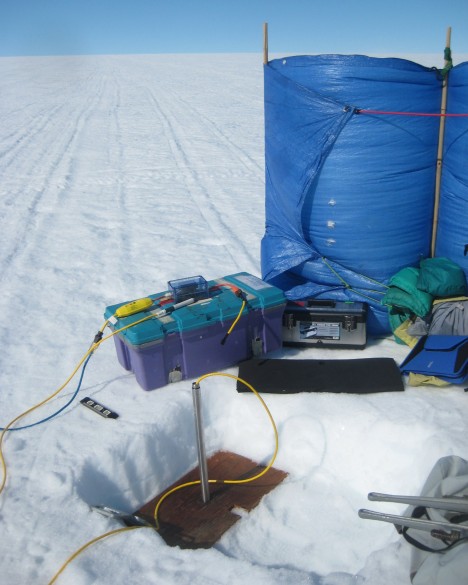One of the great things about this collaborative research project is that each researcher uses very different techniques to study the firn aquifer and we will put all our results together to get the most comprehensive understanding of the aquifer. We use science techniques that look at different aspects and scales of the aquifer, from ice cores and water wells focused on single points on the ice sheet to radar, MRS, and seismic techniques that look at meters to hundreds of meters of spatial coverage. Each technique yields different, yet complementary data, particularly since we were able to use each technique at the same locations.
We were incredibly lucky with the field conditions for this season and, as a result, the hydrology work went very well. The weather was the complete opposite of what we experienced in the spring. We had warm sunny days with almost 24 hours of daylight. In the spring we had issues with water freezing in the tubing we used to take water samples of the aquifer. It was warm enough that we had no problem with that this time.
Because of the good weather, we were also able to drill into the aquifer at two sites for the hydrology work. We took samples and measurements that will show us how the aquifer changes spatially. We took water samples, measured the water level of the aquifer, and did several tests to measure how quickly water moves through the firn.
We also took samples of ice cores and water at different depths that we will measure tritium (an isotope of hydrogen that was released into the atmosphere as a product of nuclear weapons testing) in to determine how old the firn and water at each depth is. Tritium in the atmosphere was most concentrated in the 1960s and has been decreasing since them. We can measure the amount of tritium in a water sample to see how old it is. Annual layers of snow and ice preserve the atmospheric history of tritium in the atmosphere. As you drill ice cores from greater depths, you move back in time. In the spring we were really close to sampling the tritium peak so we are hoping that we drilled our ice cores deep enough to sample the peak this time.
My next steps include laboratory analysis of the samples I collected. I am looking forward to getting and sharing results soon!
Tags: cryosphere, drilling, Greenland, Greenland Aquifer Expedition 2015, ice





